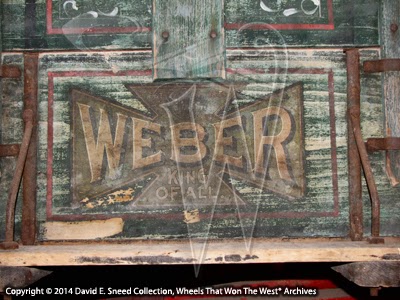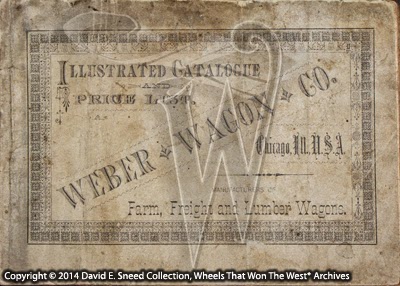One of America's most discussed and collected horse drawn wagon brands is Weber. Like many other prominent early vehicle builders, the look of Weber's products changed over time. That said, most surviving Webers with sufficient paint have at least one part of their outward appearance in common. Positioned within the logo is the date of the firm's beginnings - 1845. That's about as much nineteenth century company history as many sources ever share. With that in mind, we decided to open up a few of the primary source materials in our collection and pass along an overview of what was happening with the business during some of the most exciting days of the American West. As always, all of our images, text, and works are protected by copyright and cannot be reproduced without prior written approval from the Wheels That Won The West® Archives.
 |
| This well-worn logo from a twentieth-century-built Weber includes an IHC symbol (International Harvester Corporation) and the 1845 date at the top of the design. |
Born in 1822, Henry Weber set out for America when he was eighteen. It was a sailing voyage that lasted just over a month. (And I thought my last cross-country trip was long!) He apprenticed as a wagon maker for three years in New York before heading west to Detroit, Michigan. The future 'Motor City' capital couldn't hold him, though, and he soon set his eyes on Chicago. Arriving there midway through 1844, he immediately found work in an established wagon shop. By the following year, Weber was working on plans for his own vehicle business. With a $250 investment, he and partner, Jacob Gauch, hung out their shingle as wagon makers in 1845. The slow but steady business was not enough to hold Mr. Gauch. With news of California's gold strikes, wagon work seemed a slow way to make a living. Determined to make his fortune farther west, in 1849, he sold his share to Henry and providence began to take root for Mr. Weber.
In less than a decade, Weber had outgrown his humble beginnings and began to expand his operations. By the spring of 1871, the company was expanding again. This time to a large 4-story brick building. It was one of the few structures to survive the Great Chicago Fire in October of the same year. Escaping one inferno, though, was no guarantee of future getaways. Luck ran out for Weber in August of 1887 when a fire ravaged everything but his stock of lumber.

Marking the year of its incorporation, this original 1883 catalog is a rare survivor. It's filled with details of Weber's early farm, freight, ranch, businesses, and personal vehicle offerings.
After thirty-eight years in business, the company finally incorporated in 1883. With $150,000 of fresh capital to work with, they had traveled far from the first day with just $250 and a dream.
By the mid-1890's, the Weber Wagon Company is reported to have been producing 16,000 wagons and bobsleds annually. With a strong distribution system, they were recognized throughout the U.S. as a quality and highly desirable brand. Such was the growth that it attracted considerable attention from buyers who wanted to purchase the entire company. In a move to compete more effectively in the lucrative wagon market, International Harvester Corporation purchased Weber in 1904.
If you're a Weber fan, you can find more details on the company's history with International Harvester by contacting the State Historical Society of Wisconsin.